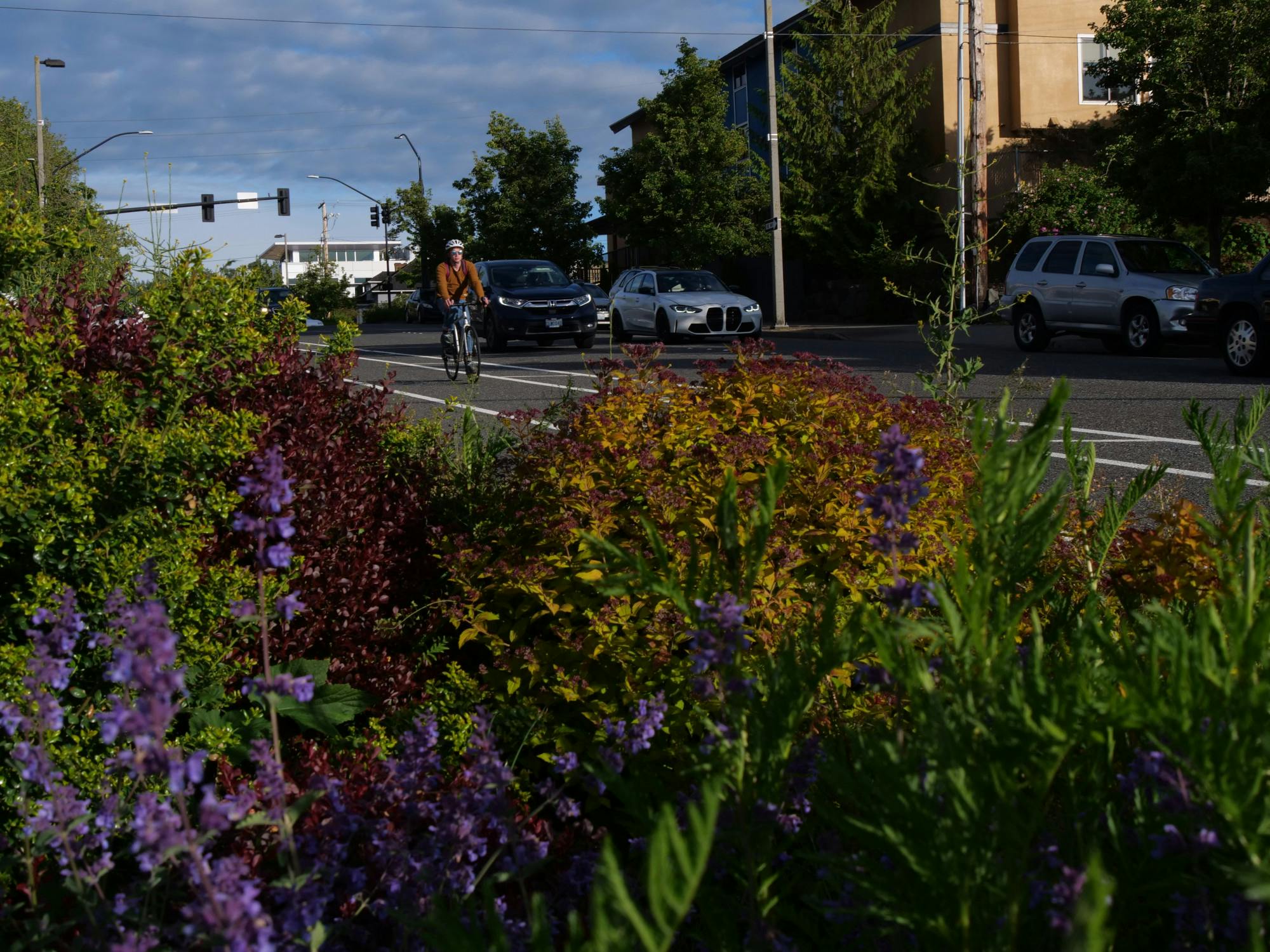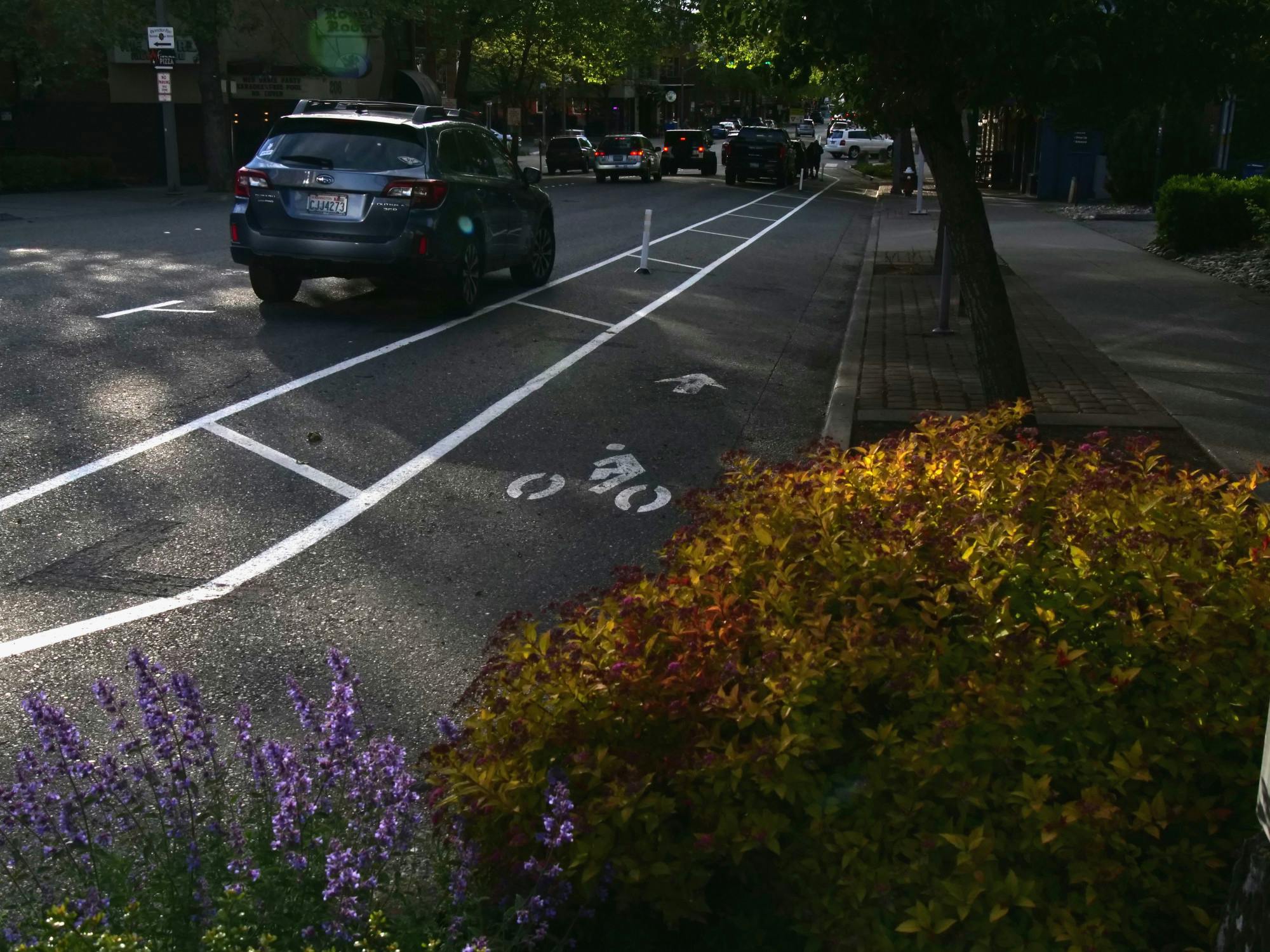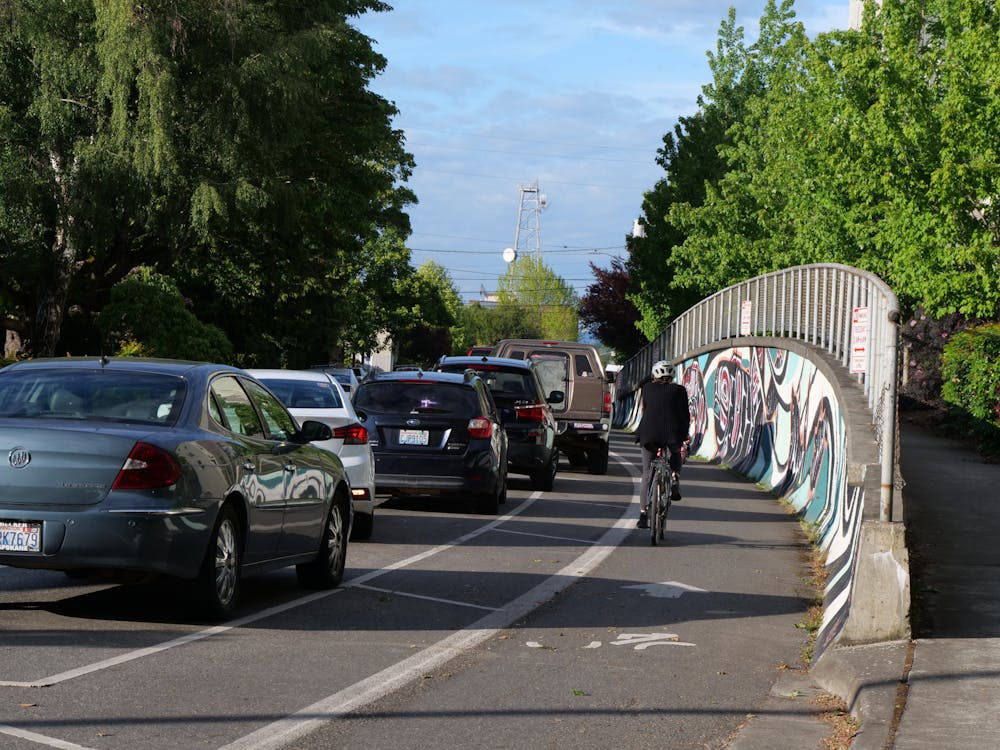Less than two weeks after debuting its Holly Street bike lane pilot in early May, the City of Bellingham received hundreds of responses and reactions. The project removed one of three lanes of vehicle traffic from Holly Street, turning it into a separated bike lane.
Feedback came in the form of 333 survey responses, 73 comments on Engage Bellingham’s website and hundreds of emails, according to Natalie Monro, the city’s Public Works communications and outreach coordinator.
The new bike lane is a pilot project designed to make downtown bicycling safer and more accessible, according to Shane Sullivan, Bellingham's city transportation engineer. This level of engagement is not typical for a city project, but the feedback will be used to make changes as necessary.
“This was set up as a pilot so that we could see if it worked,” said Monro. “We wanted to make sure that we got it right.”
As part of its Bicycle Master Plan, the city removed a vehicle lane on Holly Street, between Ellis and Bay Streets, replacing it with a bike lane. According to Sullivan, data and community feedback will be collected until the pilot ends in August.
“The goal of this … is to create a safer and more comfortable link in the bike network system,” Sullivan said. “This section of Holly is the last downtown arterial [road] that does not have a dedicated bike facility — the missing link in that network.”
The lower section of the new bike lane is parking-protected, meaning that parked cars serve as a buffer between cyclists and moving cars. However, the parking may make bicyclists less visible to cars taking right turns. One local cyclist, Kevin Herrington, was recently hit by a truck on the new bike lane.
“In mid-May, I rode down the new Holly Street bike lane and had a driver right-turn into me,” Herrington said. “The driver told me they didn't know there was a bike lane behind the line of parked cars, so they didn't look for cyclists.”
Much of the community responses on Engage Bellingham’s website are related to perceptions of safety, cyclist visibility and traffic congestion.
“To be honest, we've heard a lot of frustration from people,” Monro said. “It's a lot to sift through, but also it's good information.”
To address concerns about visibility, the city introduced leading pedestrian indicators, which give pedestrians and bicyclists a three-second head start on cars.
“Research shows that we reduce crashes by about 15 to 17 percent by implementing those,” Sullivan said. This is an estimate from a review of crash modification factors for leading pedestrian indicators from the CMF Clearinghouse.
Nathan McNeil, a research associate at the Transportation Research and Education Center at Portland State University, said that the bike lane should have positive effects on downtown.
“There are some studies out there that show that having more bicyclists and having good bike infrastructure is actually good for businesses,” he said.
The parking-protected bike lane on Holly isn’t the first in Bellingham. The roundabout on Forest Street has had a parking-protected bike lane since 2017.
Parking-protected bike lanes have been studied and found to be effective in a number of cities, McNeil said. “Parking-protected bike lanes are not that uncommon.”
Vancouver, Washington and Boulder, Colorado have both implemented similarly protected bike lanes that place a physical barrier between vehicle lanes and cyclists, according to their websites.
“One of the major themes that we heard out of the 2024 update to the Bike Master Plan was that people want us to have separated and protected bike lanes — that paint is not enough to separate bikes from traffic, especially when we're talking about cyclists who aren't as confident getting in the road and being in the mix of traffic,” Monro said.

As an experienced cyclist, Herrington said he was already confident riding in vehicle lanes on Holly, without the parking-protected lane.
“I appreciate the bike network growing anyway,” he said. “It's such a minuscule inconvenience for drivers to take away a car lane, but makes a world of difference for bikes and other personal forms of transit.”
Drivers adjust to changes in traffic patterns by filling whatever space is available to them, McNeil said.
“There's the old saying that you can't build your way out of congestion,” McNeil said. “For the most part, drivers do tend to adjust behavior. Maybe it becomes a little bit less convenient to drive and so they might think about other ways of getting around or maybe they'll take a different route.”
The city is observing driver and cyclist behavior to learn more about traffic patterns on Holly, according to Sullivan.
“We often in the city will kind of make those decisions, as planners and engineers do, but we knew that this one was going to be one that was going to have a bigger impact,” Monro said. That’s why they chose to roll out the bike lane as a pilot program first.
The City will continue collecting data over the summer to improve the Holly Street bike lane pilot.
“We'll probably do a second push to get input later in the summer, once people have settled in and are used to it a little bit more, and see if it's functioning better, the same or people are liking it a little bit better,” Monro said.
Based on data from survey results, observations on changes in traffic patterns, and other feedback, Sullivan said the city will make changes to improve the bike lane.
“It was never meant to be [an] ‘Oh, this is how it's going to be forever’ sort of thing,” Sullivan said. “The fact that we got so much feedback is a sign that people are engaging.”
The most effective way to give the city feedback on the project is to take its survey. Participants are asked what method they used to travel on Holly Street, how safe they feel now that the pilot bike lane is installed and whether they feel more or less motivated to travel on Holly Street.
“The survey is really asking the questions that we're going to be able to take action on and do something with,” Monro said.
Some cyclists, like Herrington, want to see those changes sooner rather than later.
“The safety of the lane is sub-par. I think everyone knows that by now,” Herrington said. “The city seems extra attentive to feedback on this project, so I know it will improve. I just hope the changes come before anyone else gets hurt.”

The lower section of the Holly Street bike lane in Bellingham, Wash. on May 22, 2024. The lane is parking-protected, with parked cars separating cyclists from vehicle traffic. // Photo by Oren Roberts
On May 24, Monro said that the city would temporarily block off parking at the four parking-protected intersections on Holly until they can add in bike lane “bend-ins”, which are a solution from a bike lane design guide by the Federal Highway Administration aimed at addressing visibility issues while turning.
In order to implement the bend-ins, Monro said they are temporarily blocking off four parking spaces downtown.
“We didn’t do bend-ins initially because our design constraint was to not have any reduction to parking,” Monro wrote. “However, in light of the general feedback and [Herrington’s experience] (which we were made aware of previously), we have decided to remove the parking in order to improve the safety of the bike lane.”
As of the publication of this story, the Holly Street bike lane still has parking near the intersection.
Though the adjustment process can take time, McNeil said it was good to envision possible transportation futures that include more bicycle-centric designs.
“As a country, we put the rights of cars above just about anything else,” he said. “It's a slow process to convince people that, if we can think differently, we can have great urban spaces and we can have nice downtowns.”
Being hit by a car on the Holly Street bike lane has not deterred Herrington from the idea of cycling in Bellingham.
“I hope everyone gets out of their cars and takes in the fresh air, the weather and the seasons on a bike sometime,” he said. “It's very freeing.”
Oren Roberts (they/them) is a city news reporter this quarter at The Front. They are a third-year completing an interdisciplinary concentration in Trauma-Informed Journalism through Fairhaven College. They fill their free time with fermentation projects, paddleboarding and tending to their houseplants. You can contact them at orenroberts.thefront@gmail.com.






